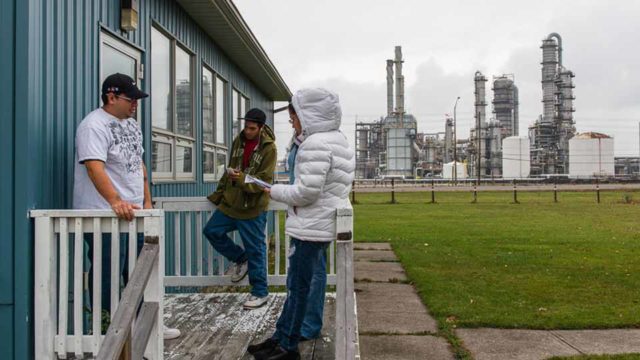National air quality standards could help Canadians recognize a basic human right: the right to breathe clean air.
When we talk about human rights, we’re often talking about fundamental concepts such as the right to practice our religion, the right to freedom of expression, or the right to love and marry an individual of our choosing. Some human rights – such as the right to breathe clean air — are even more basic. They’re necessary for life itself.
Ecojustice has long advocated for the right to a healthy environment to be included in Canada’s Charter of Rights and Freedoms. But in the absence of that recognized right, we also see the importance of closing gaps in our existing laws.
Today (May 3) is World Asthma Day. It’s also a stark reminder that unlike other industrialized countries, Canada lacks binding national standards to protect the quality of air we all breathe.
Elsewhere in the world, these standards are aimed at protecting the health of communities by setting limits on commonly-emitted pollutants such as particulate matter, sulfur dioxide, and ozone.
In the United States, for example, the Clean Air Act mandates plans to achieve and maintain air quality standards across the country. It also includes requirements for industry to use best-available technology to minimize emissions, and contains specific provisions dealing with toxic air pollutants that pose health risks to residents.
Since the Clean Air Act was first passed in 1970, our friends at Earthjustice say it’s proven a “remarkable success.”
The numbers certainly speak for themselves. According to the United States Environmental Protection Agency, the Act helped prevent approximately 205,000 premature deaths in its first 20 years alone. In that same time span, it also prevented an estimated 18 million cases of respiratory illness in children, 843,000 asthma attacks and 21,000 cases of heart disease.
Air pollution poses serious risks to life and human health
Our understanding of the links between air pollution and human health has grown significantly in the decades since the U.S. passed the Clean Air Act. Yet Canada lacks legislation similar to that of our neighbours to the south.
A study published in the journal Nature in September 2015, found that outdoor air pollution leads to more than three million premature deaths around the world each year — more than the number of deaths from malaria and HIV/AIDS combined.
Another study in the U.K. found that individuals exposed to air pollution face an increased risk of death for many decades after exposure.
This means that the health effects of air pollution are long-lasting, and have serious implications for community health. It also highlights the difficulties in proving that a given respiratory, cardiovascular, or other health problem was caused by exposure to air pollution. We know exposure increases risk, but it’s often impossible to prove an illness was caused by pollution, let alone pollution from a specific source.
Children are particularly vulnerable to the effects of air pollution, due to their smaller bodies, developmental stages, and rates of metabolism. For instance, when mothers are exposed to pollution from traffic during pregnancy, their babies face an increased risk of developing asthma early in childhood. Mothers exposed to high levels of polycyclic aromatic hydrocarbons (PAHs) during pregnancy are more likely to have children with attention deficit hyperactivity disorder or other disruptions in brain development.
Protecting all Canadians from unsafe air pollution
As we reported in Exposing Canada’s Chemical Valley (2007), air pollution is serious concern in Canada too. For instance, approximately 40 per cent of Canada’s chemical industry is located near Sarnia, Ont. This area, commonly known as “Chemical Valley”, is one of the most polluted places in the country. It is also home to the Aamjiwnaang First Nation, where residents report higher-than normal respiratory and other health problems.
According to Statistics Canada, the average rate of asthma in Canadians aged 12 and older is 8.1 per cent. In Aamjiwnaang, a community survey found that 17 per cent of adults and 22 per cent of children surveyed have asthma; more than 40 per cent of band members require the use of an inhaler.
What is happening in Chemical Valley and other pollution hot spots in Canada is unacceptable.
Human life and dignity depend on a healthy environment. Without the clean air, water, and food necessary to sustain life, we cannot realize our potential as human beings. Simply put, environmental rights are the foundation from which all other human rights are made possible.
Protecting Canadians from unsafe levels of air pollution is not only a question of good governance. Given that some communities are more exposed than others, it’s also a matter of social justice. Time and again, studies have shown that low-income and other socially-disadvantaged communities bear a disproportionate burden of environmental hazards.
Socially and economically-marginalized communities are also less likely to have the capacity to effectively mobilize opposition to new polluting facilities and to participate in decision-making processes to ensure their interests are considered.
Given these significant social and health implications — especially for children — protecting communities from the health risks associated air pollution should be a top priority for the Canadian government. Whether included in an existing law such as the Canadian Environmental Protection Act or by way of a new statute, national and enforceable air pollution standards would be a step towards a more equitable society, in which disadvantaged communities aren’t left bearing more than their fair share of the national environmental health burden.
In short: Enacting this type of legislation in Canada could help residents in Chemical Valley and other pollution hot spots breathe a little easier. And here at Ecojustice, we believe that is something worth doing.



